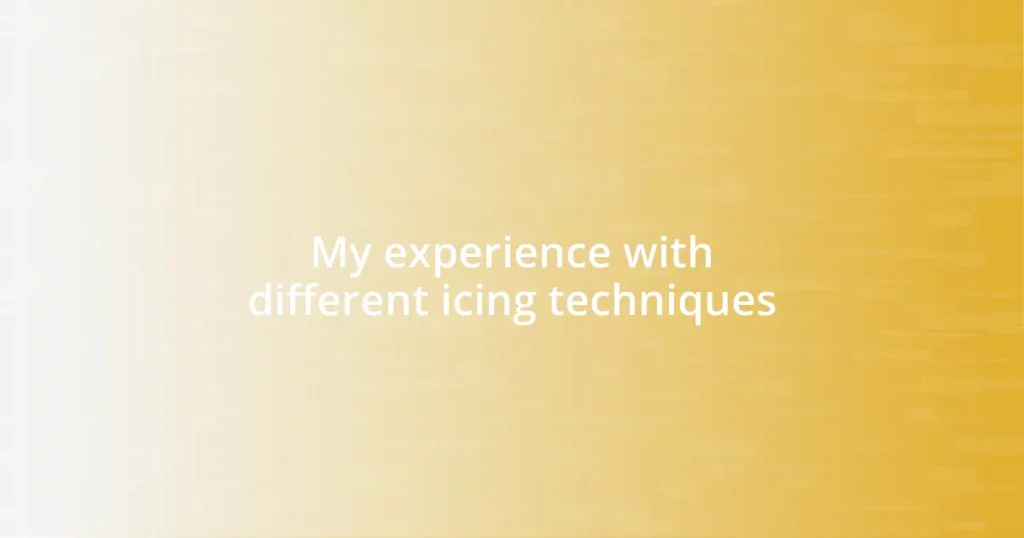Key takeaways:
- Mastering icing techniques enhances creativity, presentation, and overall enjoyment in baking.
- Practical tips, like temperature control and using the right tools, are essential for achieving perfect icing results.
- Common issues, such as air bubbles and drying time, can be mitigated through careful practice and troubleshooting.
- Icing serves as a form of self-expression, encouraging personal growth and connections through shared creations.

Overview of Icing Techniques
Icing techniques can transform a simple cake into a work of art, and I’ve absolutely loved experimenting with them. For example, when I first tried my hand at buttercream icing, I was amazed at how the texture and flavor added so much depth to my baked goods. It felt like a little victory every time I smoothed it on, creating a canvas ready for decoration.
As I explored royal icing for cookie decorating, I stumbled into a world of precision. I remember one holiday season, painstakingly outlining intricate designs on dozens of cookies. It was incredibly satisfying to see them come together, but boy, did I learn the importance of consistency! Have you ever had a project turn out completely different from what you envisioned?
Then there’s fondant, which, while not everyone’s favorite, has a certain allure. The first time I rolled out fondant for covering a cake, I was taken aback by its unique sheen and smooth finish. It can be tricky, but when done right, it feels like you’ve unlocked a new level in your baking journey. Do you find yourself gravitating toward the techniques that allow for the most creativity and flair? That’s certainly been my experience!

Importance of Icing Skills
The importance of icing skills extends far beyond just aesthetics; they significantly enhance the overall enjoyment of baking. I remember the first time I decorated a cake for a friend’s birthday. As I carefully piped flowers and rosettes, I felt a sense of pride and creation that elevated my enjoyment of the baking process. Each swirl and dot symbolized my journey and personal growth as a baker, reminding me that icing isn’t merely a finish—it’s an expression of creativity.
To illustrate the significance of developing icing skills, consider these aspects:
- Creativity: Mastering various techniques allows for endless creative possibilities in cake design.
- Presentation: Well-executed icing can elevate the visual appeal of your baked goods, making them more inviting.
- Flavor Pairing: Understanding different icing types can enhance and complement the flavors of the cake or cookie underneath.
- Detail Orientation: Icing teaches precision; techniques like piping require a steady hand and attention to detail.
- Confidence: As you improve, the confidence gained from mastering these skills encourages you to tackle more complex projects.
I truly believe that honing icing skills can transform not just your baking but also your entire approach to creativity in the kitchen!

Basic Icing Techniques Explored
When starting with basic icing techniques, it’s important to understand the purpose of each. For instance, I initially found buttercream icing to be my favorite – it’s versatile and delicious. The joy of whipping it up and achieving that perfectly creamy texture is truly delightful. I remember mixing in flavors like vanilla or cocoa, and each batch had its own unique twist. This technique has allowed me to express creativity while adding an extra layer of flavor to my cakes and cupcakes.
As I delved deeper, I discovered the precision required for royal icing. It’s remarkable how something so simple can require such attention to detail. I’ll never forget the thrill of achieving that perfect consistency—thick enough to outline, yet fluid enough to fill in. It felt like I was painting, and each cookie became a little masterpiece. There was a sense of anticipation in waiting for it to dry, transforming my creations into edible art. Have you ever felt that mix of excitement and nervousness about a baking project?
Then there’s the world of fondant; implementing this technique was a game changer for me. The first time I rolled it out and covered a cake, I experienced a mix of fear and exhilaration. Getting the look just right required practice, patience, and a few mishaps. But the results? A smooth, sleek finish that looks almost professional. It opened a whole new realm of possibilities for decorating that I hadn’t considered before. Have you ever felt that rush of mastering a skill that seemed daunting at first?
| Technique | Description |
|---|---|
| Buttercream | Rich and creamy; versatile for various cake types, easy to color and flavor. |
| Royal Icing | Hardens upon drying; ideal for detailed decorations and cookie designs. |
| Fondant | Soft, pliable icing; creates a smooth finish and allows for elaborate decorations. |

Advanced Icing Techniques to Try
When I first ventured into advanced icing techniques, I stumbled upon the beauty of marbling with ganache. Picture it: a silky chocolate coating elegantly swirled with contrasting colors, creating a mesmerizing effect. I vividly remember my first attempt; I ended up with a delightful mess, but the result was surprisingly stunning! Is there anything more satisfying than that moment when your cake comes together better than you imagined?
Another technique that truly changed my game was creating intricate lace designs with chocolate or royal icing. The first time I piped delicate lace onto a cake, my heart raced. It felt like I was designing a piece of artwork, and I couldn’t help but feel a surge of creativity. Watching the lace dry and transform into a stunning accent was exhilarating. Have you ever been captivated by how a simple decoration can elevate your entire dessert?
Finally, let’s talk about painting on cakes—yes, you can literally paint with food colors! I decided to try this after I was inspired by a beautiful cake in a magazine. The experience was both intimidating and liberating. I loved mixing colors and applying them directly to the cake’s surface, transforming it into a canvas. The rush of adding those final touches, knowing I was putting a piece of my heart into it, was unforgettable. Have you found yourself losing track of time while decorating, completely immersed in creativity?

Tips for Perfect Icing Results
When it comes to achieving perfect icing results, consistency is key. I’ve learned that both buttercream and royal icing need to be at the right temperature before working with them. For instance, if my buttercream is too warm, it can become runny, making it a challenge to achieve those sharp edges I adore. Have you ever struggled with a challenging texture? A little patience and a quick chill in the fridge can make a world of difference.
Using the right tools can truly elevate your icing game. I remember buying a simple offset spatula, and it was like unlocking a whole new level of precision. It made spreading buttercream so much easier and helped me create those gorgeous, smooth finishes I always dreamed of. Have you ever found that one tool made your baking process feel effortless? Investing in quality supplies can be a game changer.
Lastly, don’t forget to practice on scraps! I often use leftover cake or cookies as my test subjects. It’s a freeing experience; I can practice piping, experimenting with techniques, without the pressure of perfection. I vividly recall a session where I practiced swirls and rosettes on a pile of cookie scraps, and even though they weren’t for a big event, the sheer joy of creating something beautiful kept me smiling. How often do you take time to play with your materials just for fun?

Troubleshooting Common Icing Issues
I often encounter a few common icing issues that can throw a wrench in my decorating plans. One of the gritty culprits is air bubbles in my buttercream. If I don’t mix it just right when whipping, those pesky bubbles can appear, causing unsightly dents in the final product. I remember my first big cake challenge where air bubbles turned what should have been a smooth finish into a bumpy terrain. A quick tip I learned is to tap the bowl on the counter a few times before using it; this helps release those air pockets!
Another hiccup I frequently face is improper drying time for royal icing. It can be frustrating when I’ve put so much effort into delicate piping, only to see smudges or sagging once I attempt to stack or transport my decorated items. I always ensure a solid dry time to avoid this disaster. One time, I was so eager to showcase my creation that I hurried—only to find my lace pieces melting into a gooey mess. Since then, I religiously set a timer and walk away, using that time to tidy up my workspace instead of glancing back; it works wonders!
Lastly, color bleeding can be a real nuisance, especially when using gel colors on fondant or buttercream. I vividly recall a colorful cake that should have been vibrant but instead turned into a muddy masterpiece on display due to moisture from the icing. I learned the hard way that using the right type of food coloring and allowing an adequate set-up time can prevent this issue. Have you had a similar experience when you were expecting one look but got something entirely different?

Conclusion and Personal Reflections
Reflecting on my journey with icing techniques, I realize that each experience has shaped my skills and deepened my love for baking. The trials I faced, like battling air bubbles or timing royal icing drying perfectly, were not just obstacles but valuable lessons. Have you ever noticed how a setback can spark a newfound appreciation for the craft? It’s true; sometimes the greatest growth comes from our biggest mistakes.
I’ve come to cherish the creative freedom icing provides. One memorable moment was when I decorated a cake for a friend’s birthday, using all the techniques I had practiced. I felt nervous but excited, and seeing her reaction to the vibrant colors and intricate details made every testing session worthwhile. That moment reinforced for me the joy that comes from sharing something I’ve poured my heart into. Isn’t it wonderful how our creations can foster connections with others?
Looking back, I realize that icing techniques are more than just skills; they’re avenues for self-expression. Each practice session, whether successful or not, has taught me to embrace imperfection and to enjoy the art of creation. What about you? Have your experiences with icing or baking helped you grow in unexpected ways? I’d love to hear your stories about the lessons learned along the way.















